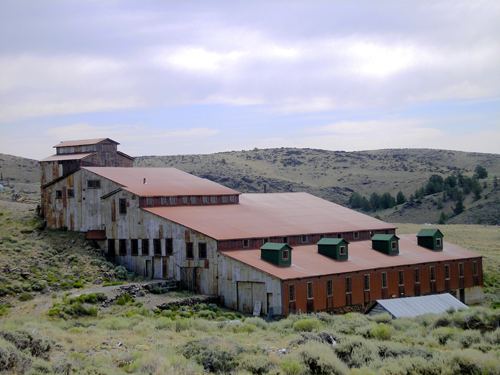NRHP Reference # 70000670 Local time Monday 9:49 PM Added to NRHP 26 February 1970 | Area 2.59 km² Year built 1867 | |
 | ||
Weather 1°C, Wind NW at 8 km/h, 94% Humidity | ||
South Pass City is an unincorporated community in Fremont County, Wyoming, United States. It is located 2 miles south of the intersection of highways 28 and 131. A former station on the Oregon Trail, it became a ghost town after later gold mines were closed. The entire community is listed on the National Register of Historic Places. The closest town is Atlantic City, Wyoming. Some people have moved back in.
Contents
Map of South Pass City, WY 82520, USA
History
South Pass City developed rapidly as a stage and telegraph station on the Oregon Trail during the 1850s. The site of the first settlement in the area was about 9 miles south of present-day South Pass City, at what is today known as Burnt Ranch. Burnt Ranch was located where the Emigrant Trails crossed the Sweetwater River for the last time and ascended toward the South Pass.
In 1866, gold was discovered in the vicinity, and a year later prospecting began on what would become the Carissa mine. Prospectors and adventurers quickly arrived and founded South Pass City. Within a year, the community's population had swelled to about 2,000. One of those who arrived in 1869, was Esther Hobart Morris. In 1870 she became the first woman in the United States to serve as a Justice of the Peace. At her urging in 1869, William H. Bright, a saloon owner and representative to the Wyoming Territorial Constitutional Convention, introduced a women's suffrage clause into the territorial constitution. When the constitution was approved by Territorial Governor John A. Campbell in December 1869, Wyoming became the first jurisdiction in the United States to grant women the right to vote, a right which was not granted women nationally until 1920.
Within a decade, the city's population shrank dramatically, as the large gold deposits that had been hoped for failed to materialize. By the mid-1870s South Pass City's population was reduced to about 100 people. Over the next century the population of South Pass City declined even further. Many of the city's homes, mercantile stores, hotels and saloons fell into disrepair. A few businesses continued to operate in South Pass City, with the last of the pioneer families finally moving out in 1949.
By the end of the 20th century, steps were being taken to renew the community, and to develop it as an historic site for destination tourism. The community in the early 21st century consists of two areas: South Pass City, in which a handful of residents live, and South Pass City State Historic Site, which preserves more than 30 historic structures dating from the city's heyday in the 1860s and 1870s. In 1970, the community was added to the National Register of Historic Places. The town has been extensively documented by the Historic American Buildings Survey (HABS) in drawings and in photographs, by HABS photographer Jack Boucher.
